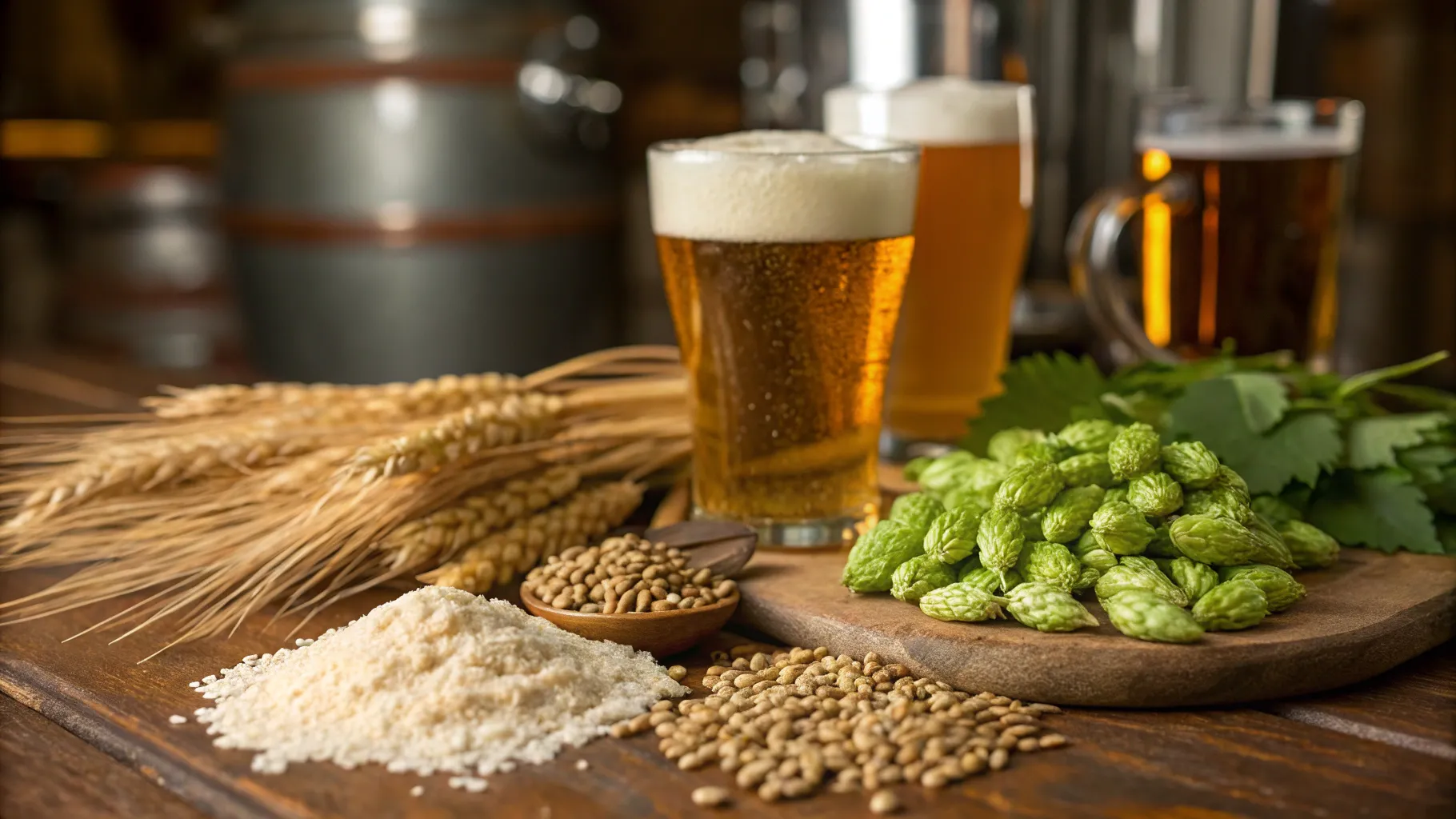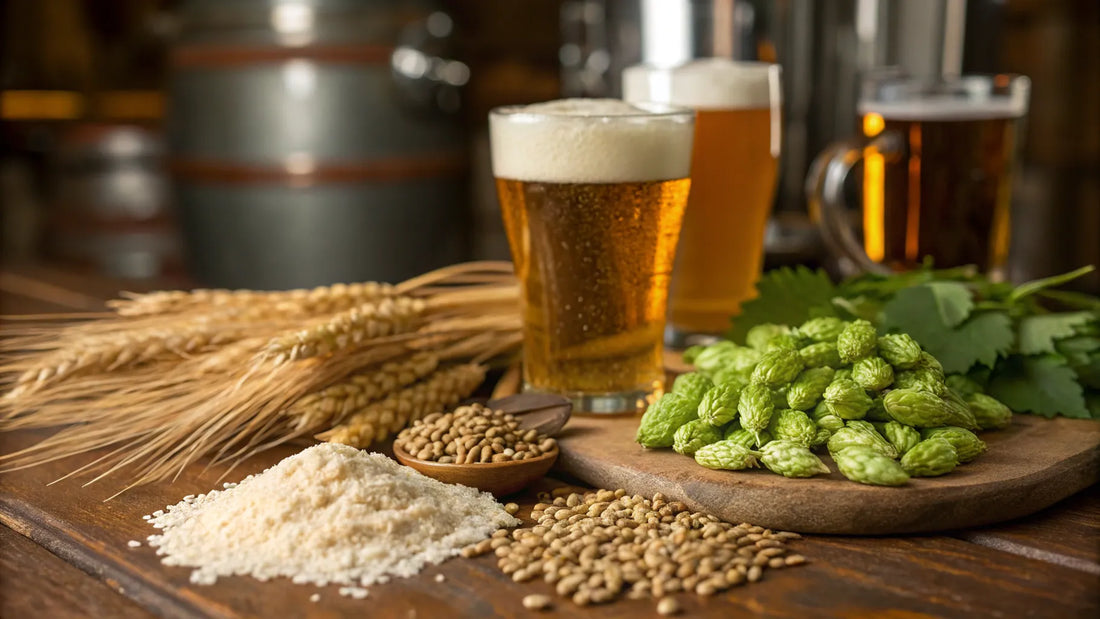Where do the flavors in beer come from?

"If you've ever tasted a beer, you've probably wondered where those unique flavors come from. In this blog, we dive into the four main ingredients of beer and discover their role in creating the diverse flavors that we appreciate so much."
🍺 Introduction to beer flavors
Beer is one of the oldest and most beloved beverages in the world. The complexity of flavors in beer is a fascinating subject for both the enthusiast and the amateur brewer. Each sip offers a unique experience, in which the different ingredients and their interactions play an important role. In this section, we explore the basics of beer flavors and how they are shaped by the ingredients and the brewing process.
What makes beer unique?
The unique flavors in beer are the result of the combination of four main ingredients: malt, hops, yeast, and water. These ingredients work together to create a range of flavors and aromas, from sweet and fruity to bitter and smoky. Understanding these flavors helps us not only to enjoy beer better but also to experiment with brewing ourselves.
🍻 The four main ingredients of beer
The core of every beer type consists of the four main ingredients. Each ingredient contributes to the final flavor and texture of the beer. Let's take a closer look at them:
- Malt: This is the base of every beer and provides the sugars needed for fermentation.
- Hops: These flowers add bitterness, aroma, and flavor to the beer.
- Gist: This micro-organism ferments the sugars from the malt and produces alcohol and carbon dioxide.
- Water: This may seem simple, but the quality and composition of water can significantly affect the taste of beer.
🌾 The role of malt in beer
Malt is the foundation of every beer. It not only provides the sugars needed for alcohol production, but it also adds a range of flavors and aromas. The choice of malt can influence the color, body, and taste of the beer.
Why is malt important?
Malt is essential for the brewing processes. It is usually made from barley, but other grains such as wheat, rye, or oats can also be used. The specific types of malt chosen determine the final flavor of the beer. From light and sweet to deep and smoky, the possibilities are endless.
🍞 Different flavors of malt
The flavors of malt can range from light and sweet to rich and smoky. This is due to the different types of malt and the kilning process they undergo. Here are some common flavors you may encounter:
- Sweet and Biscuity: Light malts often provide flavors of cookies and sweetness.
- Broody: Some malts add a bakers' aroma, which gives a full and warm feeling.
- Chocolate and Coffee: Dark malts can provide flavors of chocolate, coffee, and even toasted bread.
- Fruity: Sometimes malts can also provide subtle fruity notes, depending on the brewing techniques.
🔥 The malting process
The malting process is crucial for creating the different types of malt. This process involves soaking the grains, allowing them to germinate, and then drying them in an oven. The temperature and duration of the drying determine the final flavor and color of the malt.
Steps of the malting process
- Week process: The grains are soaked in water to start the germination activity.
- Germination: The grains are spread out and regularly moistened, causing them to begin to germinate.
- Drugs: After germination, the grains are dried in an oven, where the temperature and time influence the development of flavor.
- Malting: This is where the different flavors are developed, depending on how dark the malt is kilned.
By understanding the malting process, brewers can more accurately control and adjust the flavors and aromas in their beer. This is an essential part of the brewing process that is often overlooked, but it has a huge impact on the final quality of the beer.
🍻 The role of yeast in beer
Yeast is an essential ingredient in the brewing process of beer. This microorganism is responsible for fermentation, during which it converts the sugars from the malt into alcohol and carbon dioxide. But the role of yeast goes beyond just producing alcohol; it also adds unique flavors and aromas to the final product.
Why is yeast important?
Yeast is crucial for creating the characteristic flavors of different beer types. During fermentation, yeast produces a range of byproducts that influence the flavor. This process can lead to surprising and complex aromas, depending on the yeast strain used and the fermentation temperature.
🍺 Flavors produced by yeast
The flavors produced by yeast are diverse and can range from fruity to spicy. Here are some common flavors you may encounter:
- Fruity: Aromas of pears, apples, and bananas are often the result of specific yeast strains and fermentation processes.
- Spicy: Some yeasts, especially in Belgian beers, can impart notes of clove and pepper, which enhance the complexity of the beer.
- Doughy: A soft, bread-like smell can also occur, which is especially common in lagers and certain ales.
- Esters and phenols: These compounds provide a range of aromas, from sweet fruity notes to spicy nuances, depending on the fermentation conditions.
🌟 Specific aromas of yeast
Each yeast strain has its own unique profile that contributes to the final flavor of the beer. Here are some specific aromas you can expect:
- Peren: Often associated with Belgian beers and certain ales.
- Call: This can provide a fresh, clean taste, but in higher concentrations, it can distract from other flavors.
- Banana: A characteristic aroma in German Weissbier, produced by the right yeast strains.
- Clove: This aroma comes from the phenols produced by certain yeasts, often found in Belgian styles.
🍂 The influence of hops on beer
Hops are one of the most defining ingredients in beer. They are responsible for the bitterness, but also for the aromas and flavors that the beer can have. The choice of hop varieties and the timing of their addition during the brewing process have a significant impact on the final result.
Why is hops important?
Hops not only add bitterness but also play a crucial role in balancing the sweetness of the malt. Additionally, hops provide a range of aromatic properties that enrich the flavor experience of beer.
🌼 Aromatic properties of hops
The aromatic properties of hops vary greatly depending on the variety and the brewing process. Here are some common aromas you may encounter:
- Citrus: Aromas of orange, lemon, and grapefruit are popular in modern hop varieties.
- Tropical fruit: Mango, pineapple, and passion fruit are often found in New England IPAs and other modern styles.
- Floral notes: Some hops provide floral aromas that add a lightness and freshness to the beer.
- Pine: Hoppy beers from the US often have a pine-like aroma, which adds an earthy, resinous quality.
🍍 Tropical flavors of modern hops
Modern hop varieties have given the world of beer a refreshing twist, with tropical flavors that remind us of sunny vacations. From mango to passion fruit, these hops bring an explosion of flavors that are not only refreshing but also add complexity to the beer.
The choice of hops can completely transform the flavor of a beer style. Take, for example, the popular New England IPAs, which are often bursting with tropical fruit aromas. These beers are not only bitter but also rich in fruity notes that elevate the brewing experience to a higher level.
- Mango: A flavor often associated with modern hop varieties, providing a sweet and juicy experience.
- Pineapple: This adds a refreshing and tropical touch, perfect for a sunny day.
- Passion fruit: A complex flavor that can be both sweet and sour, adding an interesting layer to the beer.
- Papaya: This flavor is less common, but can offer a subtle sweetness and a creamy texture.
🧪 The interaction between ingredients during the brewing process
The brewing process is a fascinating dance of ingredients. Each element, from malt to hops and yeast, plays a crucial role and influences the final taste of the beer. These interactions are not only important; they are essential for creating unique beers.
"When you heat the malt in the mash process, sugars are released that the yeast will ferment. During the boiling phase, hops are added, which not only adds bitterness but also releases the aromatic oils that determine the aroma and flavor of the beer. It is a game of heat, time, and chemical reactions."
Important interactions
- Biotransformation: This is a process in which yeast breaks down hop components and creates new flavors during fermentation.
- Heat and time: The temperature and duration of cooking affect the extraction of flavors from the hops and the malt.
- Yeast activity: The activity of the yeast can vary depending on the temperature, leading to different flavors and aromas.
💧 The role of water in beer
Water is the most abundant ingredient in beer, but its impact is often underestimated. It not only affects the flavor but also the texture and mouthfeel of the beer. The minerals in water can accentuate or weaken the different flavors in the beer.
For example, water with a high calcium content can enhance the sweetness of the malt, while a higher sulfate concentration can accentuate the bitterness of the hops. This is crucial for creating the desired flavor profiles in different beer types.
Water chemistry and taste
- Calcium: Strengthens the malt characteristics and provides a fuller flavor.
- Magnesium: Essential for yeast health and promotes good fermentation.
- Sulfates: Enhance the bitterness and pithy flavors of hops.
- Chlorides: Can enhance the sweetness and fullness of the beer.
🔍 Conclusion: The complexity of beer flavors
Beer is an incredibly complex product that arises from the interaction of its ingredients. Malt, hops, yeast, and water work together in a delicate balance that leads to the unique flavors we so appreciate. By understanding the nuances of these ingredients, we can better enjoy the beers we taste.
Whether you are a seasoned beer lover or just starting out, discovering the different flavors and aromas in beer is an exciting journey. Each sip tells a story of the ingredients and the brewing process, and it is up to us to appreciate that story.
So the next time you taste a beer, take a moment to reflect on the flavors you experience. Where do they come from? How did they originate? The answer lies in the complex world of beer and its ingredients.





